
Publisher:
Bonnie King
CONTACT:
Newsroom@Salem-news.com
Advertising:
Adsales@Salem-news.com

~Truth~
~Justice~
~Peace~
TJP
Jun-17-2012 00:22

 TweetFollow @OregonNews
TweetFollow @OregonNews
The Plight of Indian Tamils in Sri Lanka
Visvanathan Sivam for Salem-News.comStatistics reveal a more than 50 per cent fall in the Indian Tamil population between 1971 and 1981.
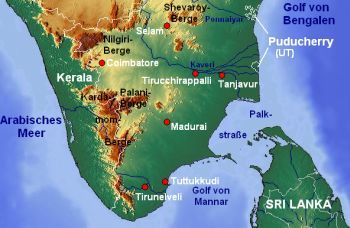 |
(CHENNAI, India) - The Tamils in Sri Lanka can be classified into two groups. The Sri Lankan Tamils, who either descended from the old Jaffna kingdom or who came along with the invading Tamil Kings of Tamil Nadu, live in the Northern and Eastern Provinces of Sri Lanka and those provinces had been their Homeland for the past 2,500 years. Tamils, who are descendants of bonded Tamil labourers brought in by the British to man the tea plantations, form the second category.
They toiled in the humid malaria infested jungles to develop the tea plantations in Central Sri Lanka in the 19th century. They lived under most miserable conditions without proper housing or medical facilities and received a remuneration that could hardly keep their bodies and souls together. Needless to say a substantial number of them died of diseases. They are often referred to as Indian Tamils or Hill Country Tamils. This article deals on their present plight and what they have achieved at the end of their sacrifices.
This doesn’t mean that before the emergence of Tamils in Sri Lanka the whole island was occupied by the Sinhalese. Their chronicles depicted their mythical king Vijaya and his followers, who were exiled from northern Indian state of Orissa, as the original settlers of Sri Lanka. Two Dravidian races, Nagas and Yakshas were the original inhabitants of the island. They could be Tamils, as Tamil Nadu is only 20 kilometers away. Moreover, the Tamils were a sea-faring race; northern Indians on religious grounds shunned the sea.
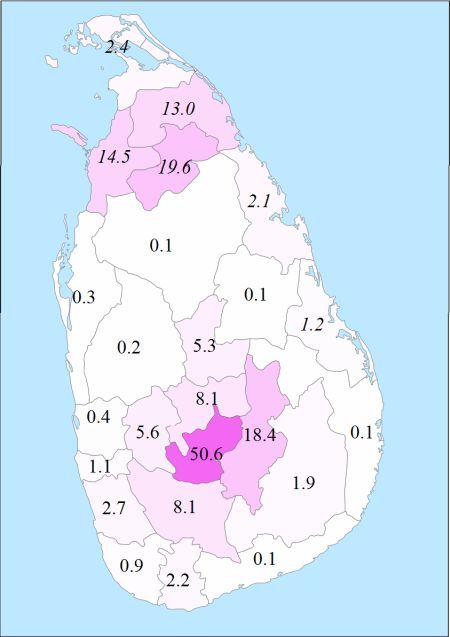
D.S. Senanayake of the United National Party introduced the Ceylon Citizenship Act of 1948, the Indian-Pakistani Citizenship act of 1949 and amended the parliamentary elections act and disfranchised the Indian Tamils. The plantation workers were thus a forgotten lot from 1948 - 1964. They were unable to profit from any progressive legislation. The housing, health and education of the plantation workers were neglected. Infant mortality was highest in the country. Economically, politically and socially they became the most deprived population group in the country.
The Indian Prime Minister, Jawaharlal Nehru protested against this Sinhalese move and refused to accept the disfranchised Indian Tamils. Prominent Tamil political leaders such as S. J. V. Chelvanayakam also protested against this move, but to no avail. This was the starting point of the Sinhala-Tamil ethnic problem. From the year of independence in February 1948 or even much earlier, the Sinhalese had been scheming the marginalising of Tamils that eventually led to Mullivaaikkal in May 2009.
The Srima-Shastri pact of 1964 and Indira-Sirimavo supplementary agreement of 1974 paved the way for the repatriation of 600,000 persons of Indian origin to India. Another 375,000 persons were accepted as Sri Lankan citizens, which allowed them to enter politics. Many Tamils consider this as a treacherous act on the part of India. These repatriation agreements were the harbingers of the destruction for the community. Both the agreements were signed by India to appease Sri Lanka to drag them into the Indian fold. To this day India’s appeasement policy has hardly brought them any closer; in fact Sri Lanka is far closer to China than India.
A substantial number of the 600,000 persons, who were to be repatriated, came to know about the fate of those who agreed to go to India; the Indian and the Tamil Nadu governments left them to live in slums and this was no encouragement for them to accept Indian citizenship. Those who refused to accept Indian citizenship burnt their documents and remained stateless in Sri Lanka.
Indian Tamil worker at a tea |
The ethnic conflict has led to the growth of a greater sense of common Tamil identity among all Tamils in Sri Lanka; the two groups are now more supportive of each other.
By the 1990s most of Indian Tamils who refused repatriation, had received Sri Lankan citizenship, mainly because of Sri Lankan fear that the Indian Tamils would join the insurgency led by Velupillai Prabhakaran.
According to the 2001 census Indian Tamils numbered 855,025 and they were distributed in the island as shown in the map below.
Percentage of Tamils of Indian origin per district based on 2001 or 1981 (cursive) census.
Census operations started in Sri Lanka in 1871. The Census of 1871, 1881, 1891 and 1901 had lumped together Sri Lankan Tamils and Indian Tamils. Since 1911, Indian Tamils have been shown as a separate category. The population statistics are revealing. In 1911, Indian Tamils constituted 12.9 per cent of the population, whereas Sri Lankan Tamils formed 12.8 per cent; in 1921, 13.4 per cent and 11.5 per cent; in 1931, 15.2 and 11.3; in 1946, 11.7 and 11.0; in 1953, 12.0 and 10.9; in 1963, 10.6 and 11.0; in 1971, 11.6 and 11.2; and in 1981, 5.5 per cent and 12.7 per cent respectively.
The statistics reveal a more than 50 per cent fall in the Indian Tamil population between 1971 and 1981. The main reason for the fall was the repatriation of Indian citizens to India. Another fact is that that many Indian Tamils, after acquiring Sri Lankan citizenship, declared themselves as Sri Lankan Tamils. Some Tamils who migrated to urban areas and also to the North and the East also followed this same example.

Tea harvesters make 500 rupees (£2.50) a day - but only if they pick 18 kg; anything less they get half the price.
Early each morning, hundreds of women add bright specks of colour to the landscape as they begin harvesting the leaves by hand. But the job is gruelling and a new sense of gloom is starting to pervade Sri Lanka's tea industry.
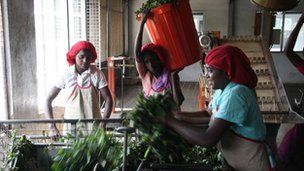 Tea production involves the leaves being withered, |
Although tea is one of Sri Lanka’s main reign earners, the industry is subject to high costs and low market prices. This affects the wages of the workers.
One of the tea-pickers, 28-year-old Selvarani Karthikesan, lives in one of the row of workers' houses located in the middle of the plantation - a modest but fairly dilapidated dwelling. Selvarani lives with her husband and four children, all aged under eight. They have no electricity or running water in the house and the only toilets are outside.
Her kitchen roof consists of sheets of corrugated iron weighed down with stones. Her family is especially hard-hit by rising costs and on some days they don't get to eat a full meal.
"It's very difficult now. Goods are very expensive," Selvarani said. "My husband does odd jobs with no secure income, so we mainly depend on my salary."
"As soon as I get paid, all the shop-owners who've given me loans, come to my doorstep to take the money. Then there's nothing left to buy even shoes or socks," she added.
As the days went by life for the Indians became more and more distressing. When LTTE was on the ascendancy, out of fear of Indian Tamils joining the Tigers, the Sinhalese did not terrorize them very much, but today that is not the case. They have to live at the mercy of the Sinhalese public.
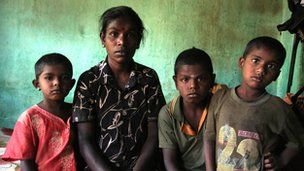 28-year-old Selvarani Karthikesan supports her |
For the Tamil families of Dilithura, a small village of mostly estate workers in Elpitiya, Galle, the Sinhala and Tamil New Year on 14 April 2012 was not to be an auspicious one. Their tragedy, which ended in burnt homes and looted possessions, began with a simple, everyday inconsequence: a young villager not calling a soldier on holiday, ‘sir’.
The enraged soldier reportedly responded to this non-crime with disproportionate and extra-judicial punitive action. According to the ‘Ada Derana’ Tamil website, he assaulted the young man, as well as another Tamil youth who tried to mediate. Subsequently, “around 30 youths had gathered at the location, beaten up the two Tamil youths and set fire to seven houses, push cycles, motorcycles and three wheelers. They had also got away with money and jewellery…” The villagers informed the police. Instead of arresting the perpetrators, the police detained two Tamil youths!
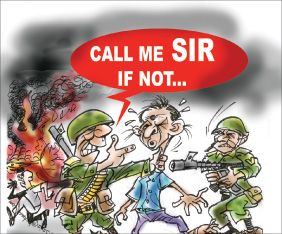
When seven Tamil families lose their homes and all their possessions because one Tamil boy did not call a soldier ‘sir’, does it not smack of collective punishment? If an outrage of this order can happen in the South, in 2012, what could not have happened in the North, in the midst of a total war without witnesses?
If a soldier on leave can take the law into his own hands with such alacrity and impunity, in Galle, what cannot the tens of thousands of soldiers on duty do in the Tamil Homeland? The Tamils there are beyond the reach of the common law where the soldiers set their own rules. You can well imagine the violence and hardship the Tamils undergo.
Coming back to the Indian Tamils, is the Indian government or their Tamil leaders in the Hill Country genuinely interested in their welfare? S.M.Krishna said at the end of last year that now he would turn his attention to the welfare of Indian Tamils. What did the Pundits or he do to ameliorate the plight the Tamils were in for the last 50 years? Why didn’t this love and compassion emerge earlier when all the eighty million Tamils were in pain? At that time they were busy helping the Sinhalese to wipe out the Tigers, the only anchor the Indian Tamils had, and those associated with the LTTE. It is only when Rajapaksa put them to shame by breaking the promises made to them, notwithstanding the broken promises made to the Eelam Tamils for the last 50 years, they come with this new typical Indian rope trick. This is another Indian appeasement game to calm down the rattled nerves of Tamil Nadu; nothing more.
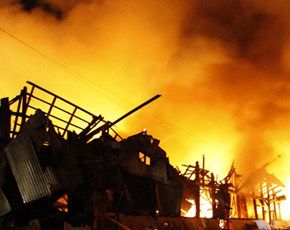 An arson-attack by Sinhalese thugs and there |
Are the Tamil leaders in the Hill country any better than the Indian leaders? This Sunday Times report on June 3 will reveal the attitude and intentions of the Hill Country Tamil leaders. President Mahinda Rajapaksa interrupted a four-day visit to Thailand to return to Colombo on June 1 morning to attend the wedding of Minister Arumugam Thondaman's daughter, Nachiyar. He returned to Bangkok the same evening after the wedding. Why did the president of Sri Lanka break his official tour to attend to a Tamil wedding in Colombo?
The answer is simple – Arumugam Thondaman is a Tamil minister through whom he controls 850,000 Indian Tamils. He throws a few inconsequential cabinet posts to these Tamil and Muslim leaders and secures their obedience. For Thondaman it is a great honour for a president to cut short his official visit to attend his daughter’s wedding. Can he complain to the government that a Tamil man had been attacked for not addressing a Sinhalese soldier ‘sir’ or the Tamil houses were burnt down and the occupants robbed? Can the Muslim ministers protest on the closure of a mosque by Buddhist monks?
There was a time the Hill Country Tamils were banking on a leader called Prabhakaran. When he was around, the Indian Tamils enjoyed relative peace. Now that he is no more there, that balance is shattered and the reign of Sinhalese thugs has re-emerged. When or from where will their salvation come? It will have come from the Eelam or Tamil Nadu Tamils, not from S.M.Krishna or the Delhi Pundits.
Visvanathan
-------------------------------
Tweet
Follow @OregonNews
Articles for June 16, 2012 | Articles for June 17, 2012 | Articles for June 18, 2012

Salem-News.com:
googlec507860f6901db00.html



Terms of Service | Privacy Policy

All comments and messages are approved by people and self promotional links or unacceptable comments are denied.
[Return to Top]
©2025 Salem-News.com. All opinions expressed in this article are those of the author and do not necessarily reflect those of Salem-News.com.